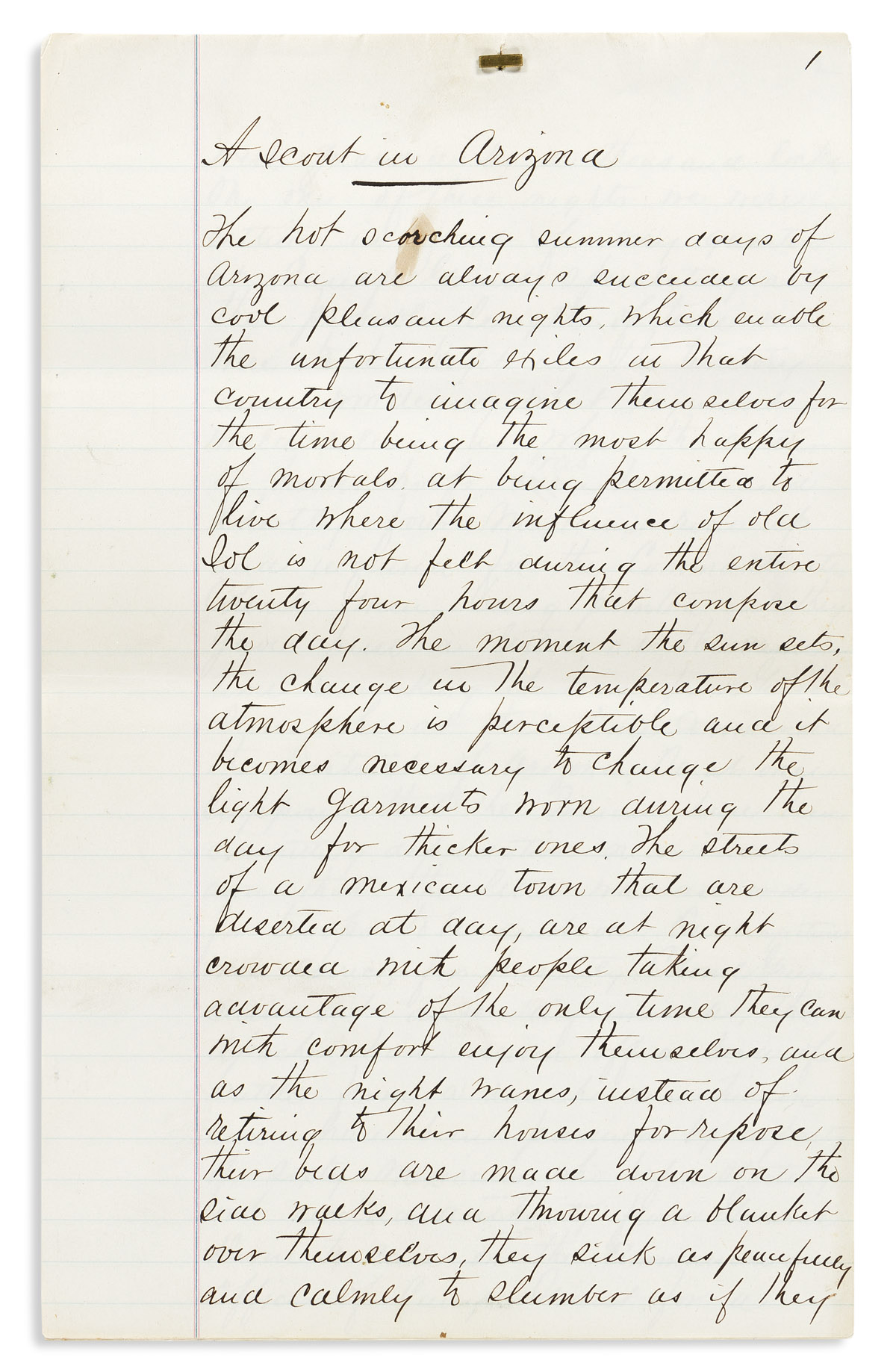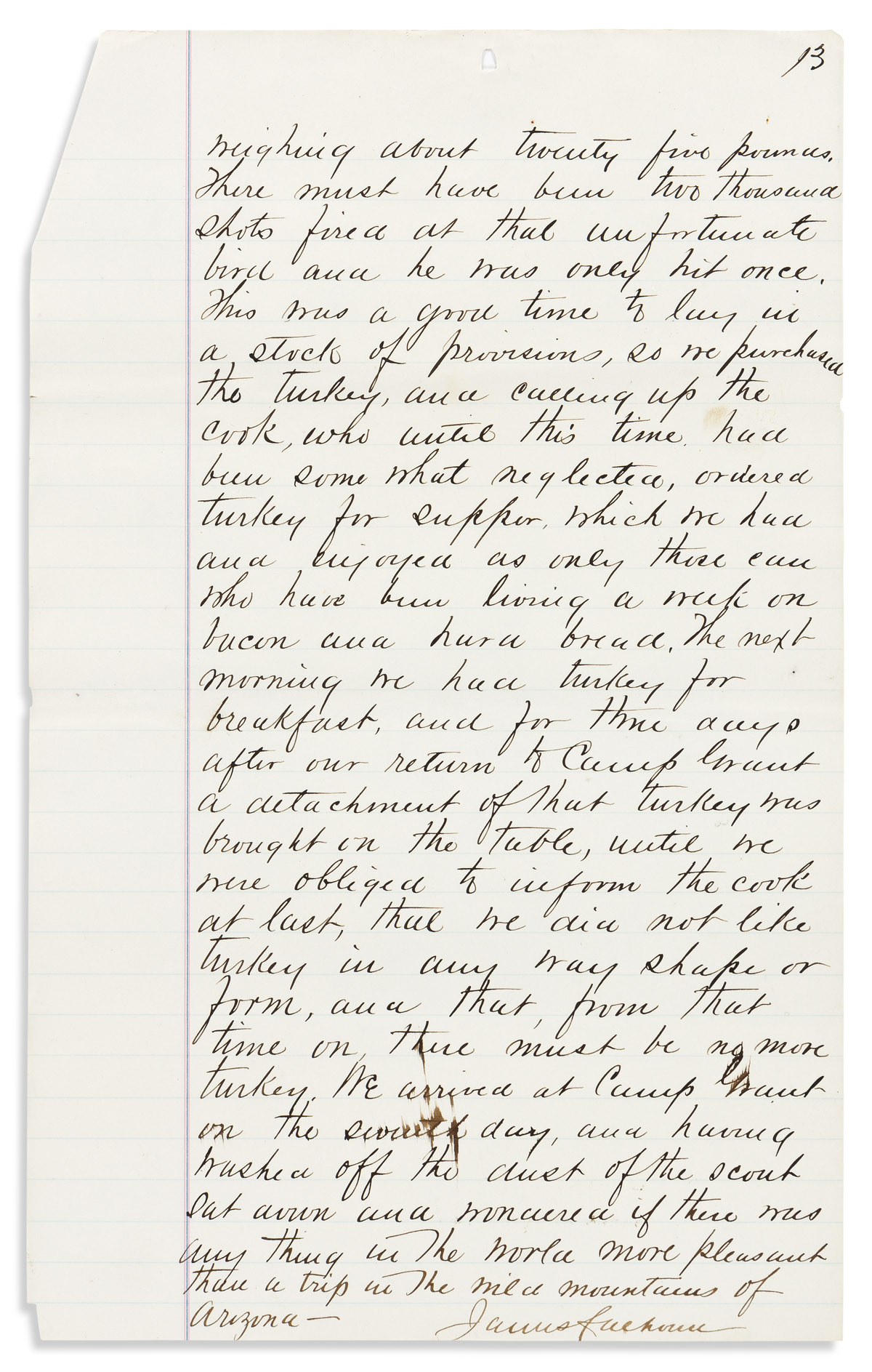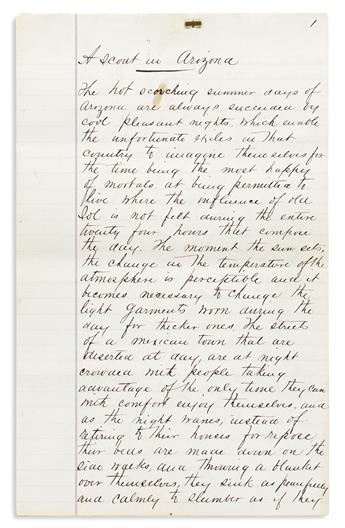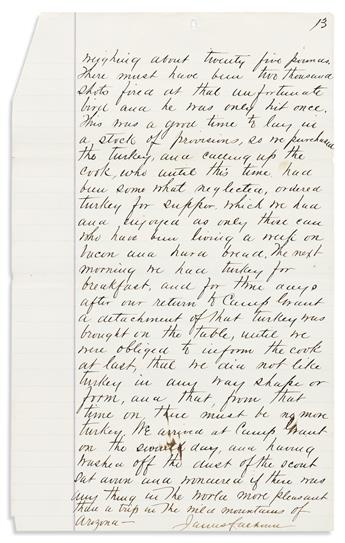Sale 2580 - Lot 252
Unsold
Estimate: $ 7,000 - $ 10,000
(WEST--ARIZONA.) James Calhoun. Scouting narrative by a lieutenant who later died with his brother-in-law Custer at Little Bighorn. Autograph Manuscript Signed with title "A Scout in Arizona," 13 pages, 12 1/4 x 7 3/4 inches, bound at top by a single metal fastener; folds, minor wear. [Arizona], circa 1869
Additional Details
James Calhoun (1845-1876) came from a wealthy Cincinnati family and joined the Union Army in 1864, becoming a career infantry officer. In January 1868 he went west with the 32nd Infantry to Fort Grant, Arizona; his regiment was consolidated into the 21st Infantry in August 1869. He later gained a most unfortunate fame as brother-in-law and comrade in arms to George Armstrong Custer at Little Bighorn.
Offered here is a narrative which Lieutenant Calhoun wrote while stationed at Fort Grant. It describes a scouting expedition which took place between February 1869 (when Colonel John Green assumed control of the post) and August 1869 (when General Thomas Devin was transferred from the District of Arizona). A band of Apaches had driven off a herd of cattle near Tucson, and Calhoun was sent to accompany a detachment of 30 cavalry in pursuit up the San Pedro River.
This is not an official report. Apparently written and signed shortly after the expedition, it is filled with sarcasm and amusing narrative details. The expedition falls in with a band of 4 Mexican civilians who were also hunting the Apaches. Calhoun hints broadly that these Mexicans were actually doing their best to avoid a confrontation, lighting large fires at night to warn of their approach. A full day's march from the camp, the expedition realized that nobody had thought to pack any provisions, forcing the men to live on whatever rations were in their packs. They continued up and over numerous mountains at great hazard to their horses, traveling by night when possible: "Walking at night over a ground covered with cactus and leading a horse who objects to being led are things that must be experienced to be appreciated." After 4 days they gave up the hunt and began a return to Fort Grant via the Aravaipa Canyon, "through which none of our party had ever been, and in fact but one party of white men ever had been through." The steep walls and slow progress made them vulnerable to ambush. At one point, with the Mexicans traveling ahead, the cavalrymen heard a barrage of gunfire. Rushing toward the fight, "as we rode up to them, the firing ceased for a moment, and someone informed us they were firing at a turkey. There they all commenced again and at last brought down a game old gobbler weighing about 25 pounds. There must have been two thousand shots fired at that unfortunate bird and he was only hit once." They returned safely to Fort Grant "and wondered if there was anything in the world more pleasant than a trip in the wild mountains of Arizona."
In January 1871, Calhoun was transferred to George Armstrong Custer's famous 7th United States Cavalry. The following year he married his commander's sister Margaret Custer, becoming one of several extended Custer family members in the regiment. At the Battle of the Little Bighorn, he was in temporary command of Company L, and died alongside the rest of his men atop what is now known as Calhoun Hill.
Offered here is a narrative which Lieutenant Calhoun wrote while stationed at Fort Grant. It describes a scouting expedition which took place between February 1869 (when Colonel John Green assumed control of the post) and August 1869 (when General Thomas Devin was transferred from the District of Arizona). A band of Apaches had driven off a herd of cattle near Tucson, and Calhoun was sent to accompany a detachment of 30 cavalry in pursuit up the San Pedro River.
This is not an official report. Apparently written and signed shortly after the expedition, it is filled with sarcasm and amusing narrative details. The expedition falls in with a band of 4 Mexican civilians who were also hunting the Apaches. Calhoun hints broadly that these Mexicans were actually doing their best to avoid a confrontation, lighting large fires at night to warn of their approach. A full day's march from the camp, the expedition realized that nobody had thought to pack any provisions, forcing the men to live on whatever rations were in their packs. They continued up and over numerous mountains at great hazard to their horses, traveling by night when possible: "Walking at night over a ground covered with cactus and leading a horse who objects to being led are things that must be experienced to be appreciated." After 4 days they gave up the hunt and began a return to Fort Grant via the Aravaipa Canyon, "through which none of our party had ever been, and in fact but one party of white men ever had been through." The steep walls and slow progress made them vulnerable to ambush. At one point, with the Mexicans traveling ahead, the cavalrymen heard a barrage of gunfire. Rushing toward the fight, "as we rode up to them, the firing ceased for a moment, and someone informed us they were firing at a turkey. There they all commenced again and at last brought down a game old gobbler weighing about 25 pounds. There must have been two thousand shots fired at that unfortunate bird and he was only hit once." They returned safely to Fort Grant "and wondered if there was anything in the world more pleasant than a trip in the wild mountains of Arizona."
In January 1871, Calhoun was transferred to George Armstrong Custer's famous 7th United States Cavalry. The following year he married his commander's sister Margaret Custer, becoming one of several extended Custer family members in the regiment. At the Battle of the Little Bighorn, he was in temporary command of Company L, and died alongside the rest of his men atop what is now known as Calhoun Hill.
Exhibition Hours
Exhibition Hours
Aliquam vulputate ornare congue. Vestibulum maximus, libero in placerat faucibus, risus nisl molestie massa, ut maximus metus lectus vel lorem.






